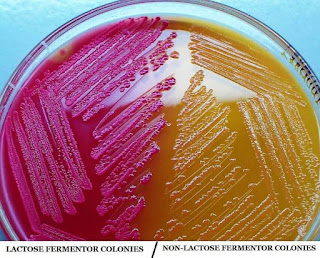MacConkey Agar : Composition, Principle and Use
MacConkey Agar is recommended for selective isolation of Escherichia coli from pharmaceutical products and is in accordance with harmonized methodology of BP. It is also recommended for selective isolation and differentiation of lactose fermenting and lactose non fermenting enteric bacteria.
Composition:
Ingredients
|
Gms / Litre
|
Peptone (meat
and casein)
|
3.0
|
Pancreatic
digest of gelatin
|
17.0
|
Lactose
monohydrate
|
10.0
|
Bile salts
|
1.50
|
Sodium chloride
|
5.0
|
Crystal Violet
|
0.001
|
Neutral red
|
0.030
|
Agar
|
13.50
|
pH after sterilization ( at 25°C) 7.1±0.2
|
|


Emoticon Emoticon